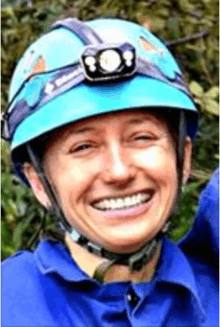Becca Peixotto
| Becca Peixotto | |
|---|---|
 | |
| Nationality | American |
| Education | |
| Known for | Discovery of Homo naledi[2] |
| Scientific career | |
| Fields |
Anthropology archaeology |
| Institutions | American University |
Rebecca Peixotto is an American archaeologist who is known for her contribution to the Rising Star Expedition as one of the six women Underground Astronauts.[3] She has also participated in the Great Dismal Swamp Landscape Study and is an experienced wilderness educator.[4]
Education
Peixotto obtained a BA in Slavic Area Studies from the University of Alabama in Huntsville.[1] She pursued further studies abroad at the University of Amsterdam, obtaining an MA in Discourse and Argumentation Studies. She returned to the U.S. to attend the American University in Washington DC where she earned a MA in Public Anthropology. Paixotto is currently working on her PhD at the American University where she is "focusing on historical archaeology and resistance landscapes of the Great Dismal Swamp".[1]
Rising Star Expedition
In October 2013, Peixotto and five others were chosen to be part of a specialized excavation team for the Rising Star Expedition.[5] The purpose of the twenty-one day expedition, sponsored by The National Geographic Society and the University of the Witwatersrand, Johannesburg was to excavate fossils which had been recently found in a deep cave complex in the Rising Star Cave System, near Johannesburg, South Africa..[6]
The critical skills and physical attributes sought for the excavation team by lead scientist and University of the Witwatersrand professor Lee Berger were: a " master's degree or higher in palaeontology, archeology or an associated field; caving experience; and the ability to fit through an 18-centimeter (about 7-inch) space. The six women scientists were crucial in the successful "excavation of arguably one of the most important fossil finds in human history – a new species referred to as Homo naledi.[7][8]
Peixotto, Hannah Morris, Marina Elliott, Alia Gurtov, K. Lindsay Eaves and Elen Feuerriegel, along with a team of sixty international scientists, excavated "one of the richest collections of hominin fossils ever discovered—some 1,550 fossil fragments, belonging to at least 15 individual skeletons."[5]
See also
References
- 1 2 3 "Faculty Profile Rebecca Peixotto". American University Washington D.C. Retrieved 8 December 2017.
- ↑ Weisser, Ryan. "Meet the Local Student Who Helped Discover a New Species". Washingtononian. Retrieved 8 December 2017.
- ↑ Feltman, Rachel. "Meet the six female 'underground astronauts' who recovered our newest relative". Washington Post. Retrieved 8 December 2017.
- ↑ "Who are the Underground Astronauts". EWN. Retrieved 8 December 2017.
- 1 2 Yong, Ed. "6 Tiny Cavers, 15 Odd Skeletons, and 1 Amazing New Species of Ancient Human". The Atlantic. Retrieved 8 December 2017.
- ↑ Shreeve, James. "This Face Changes the Human Story. But How?". National Geographic. Retrieved 8 December 2017.
- ↑ Mathy, MH. "Shining Light of Discovery". The Clarion. Retrieved 7 December 2017.
- ↑ "Ali Gurtov '07 Is One of The Rising Star Expedition's "Underground Astronauts"". Wellesley College. Retrieved 8 December 2017.